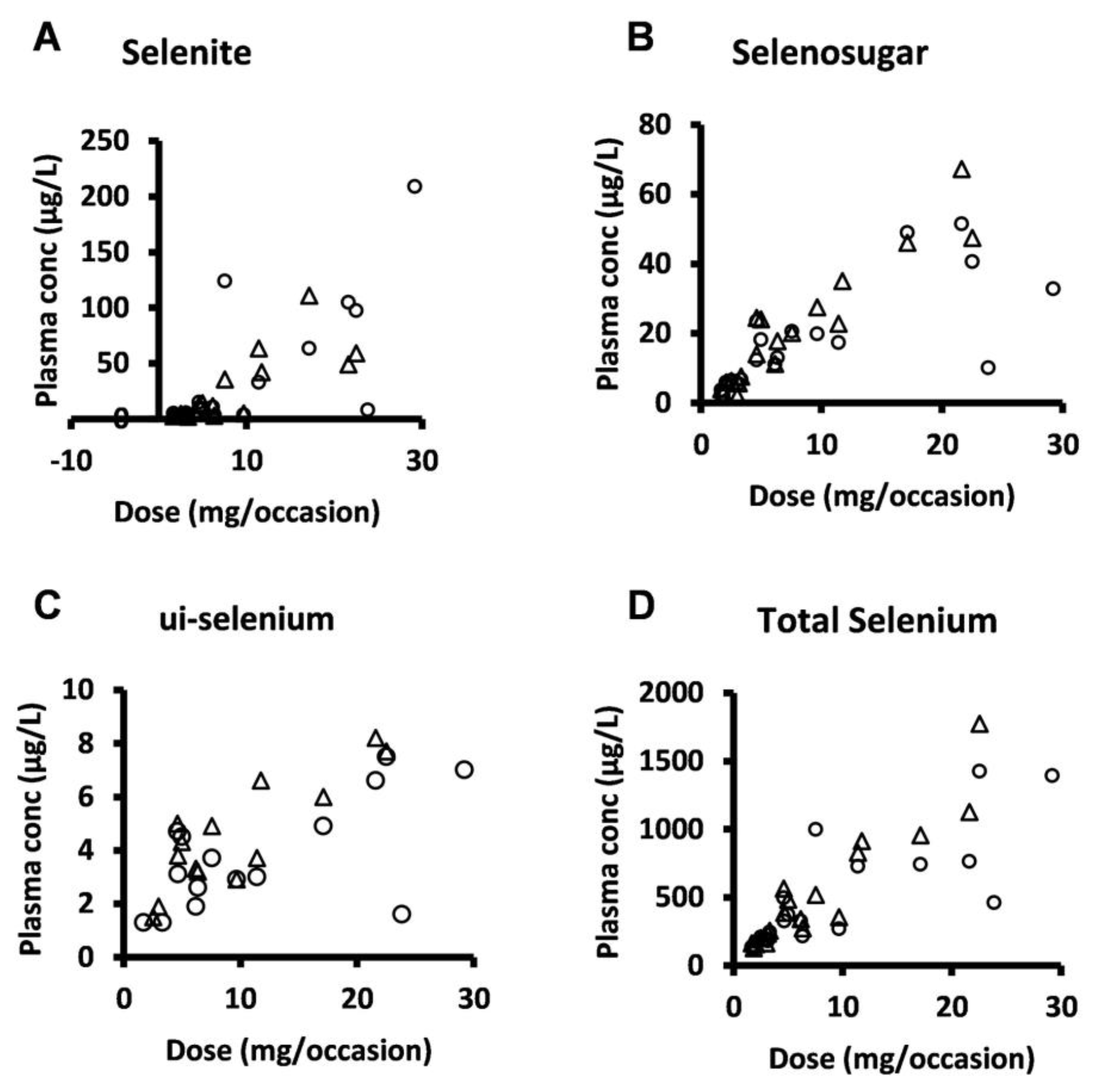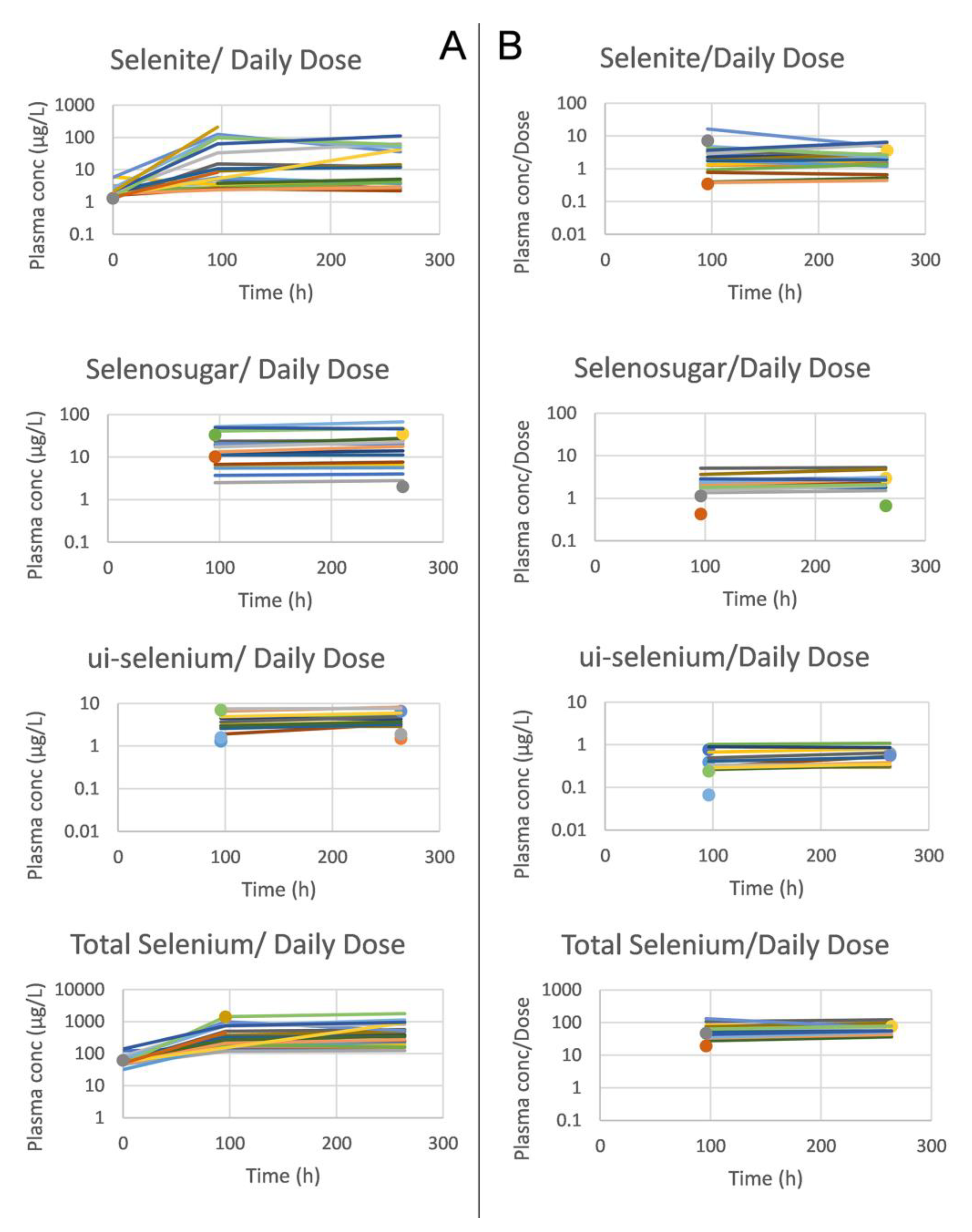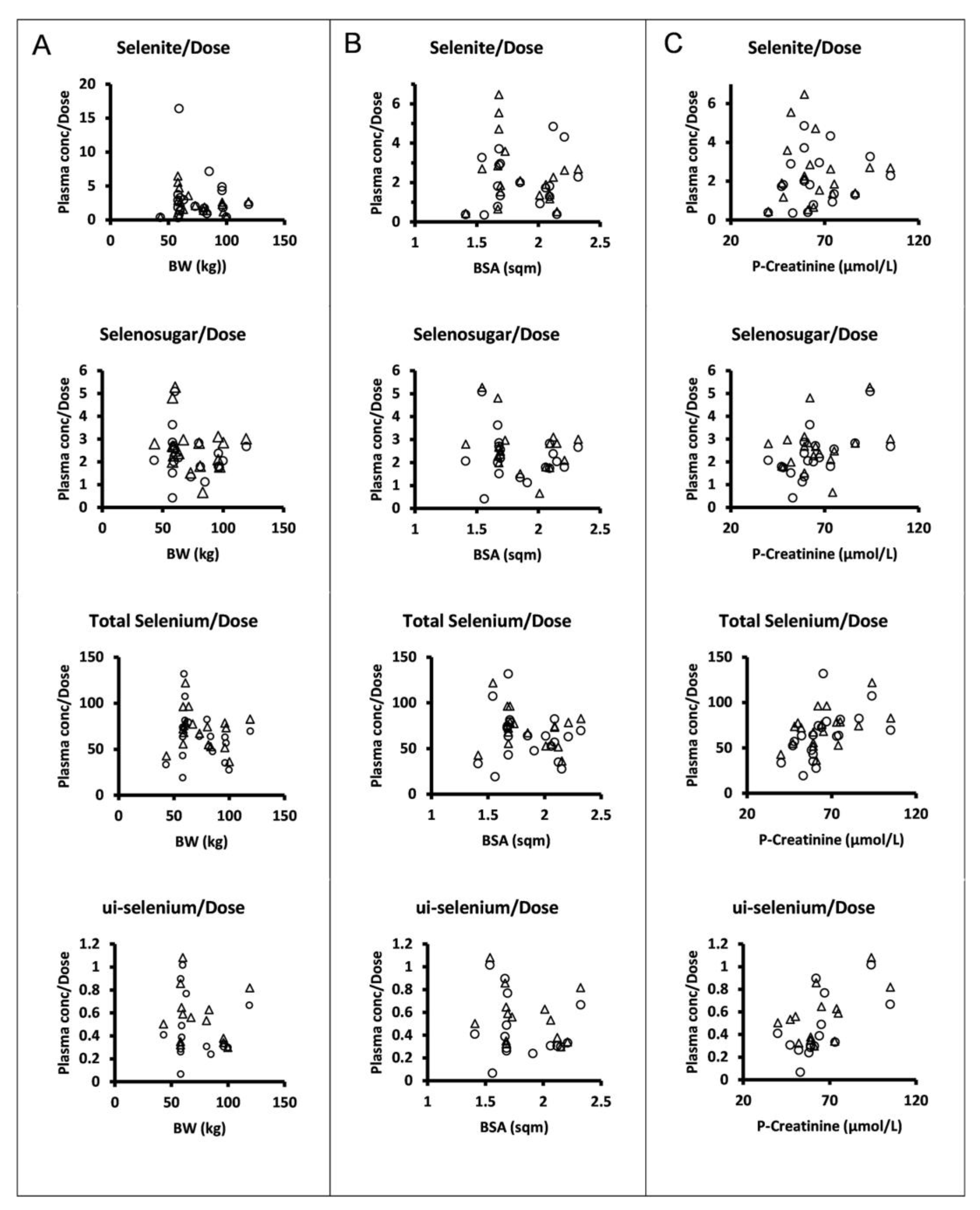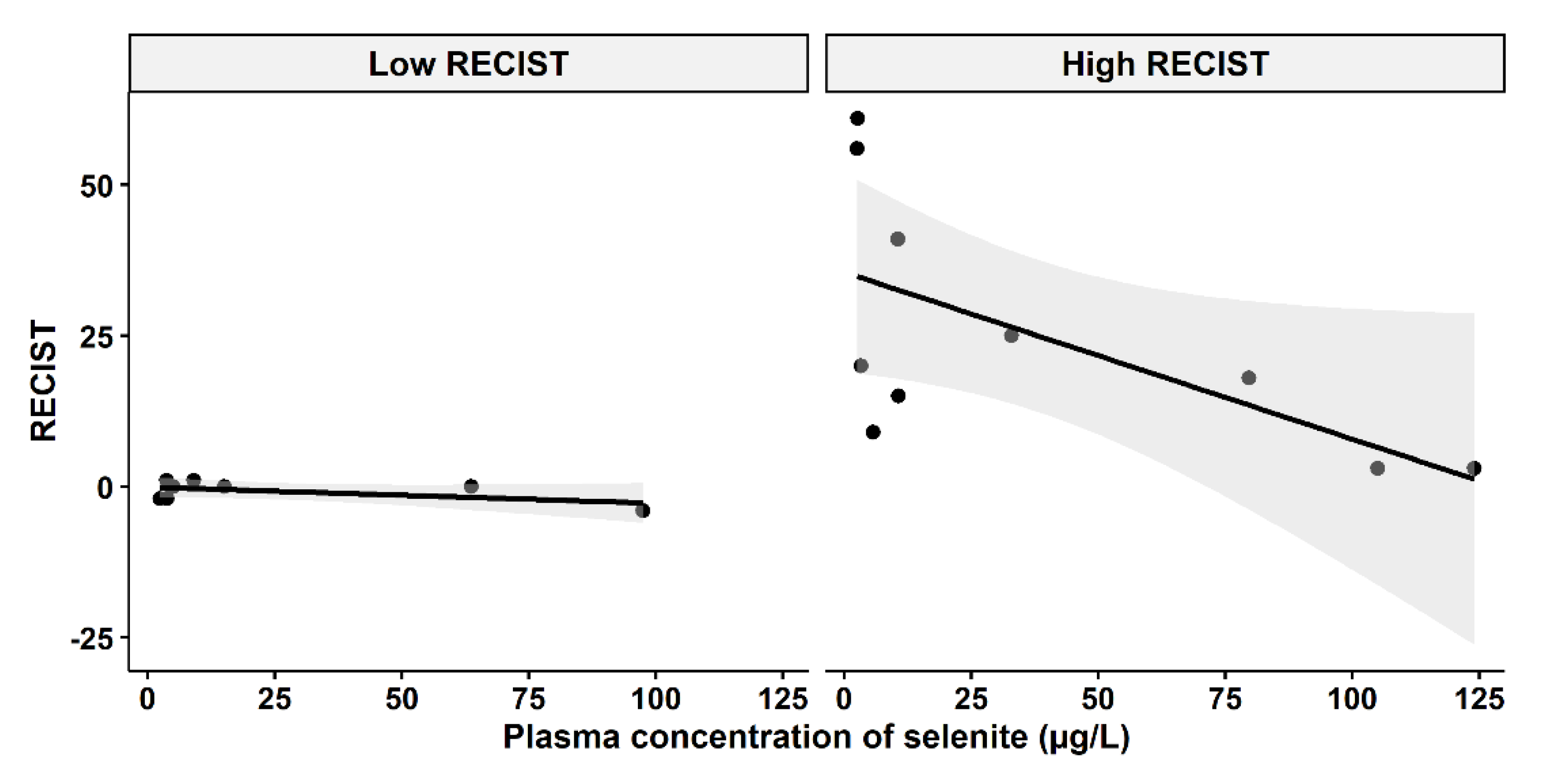Intravenous Infusion of High Dose Selenite in End-Stage Cancer Patients: Analysis of Systemic Exposure to Selenite and Seleno-Metabolites
Abstract
1. Introduction
2. Materials and Methods
2.1. Clinical Samples
2.2. Sampling Schedule
2.3. Seleno-Metabolite Analysis
3. Results
3.1. Baseline Levels of Seleno-Metabolites in Plasma
3.2. Dose-Plasma Concentration of Seleno-Metabolites
3.3. Systemic Exposure of Selenite in Relation to Patient-Specific Variables
3.4. Selenite Concentration and Tumor-Growth Inhibition
4. Discussion
5. Conclusions
Author Contributions
Funding
Institutional Review Board Statement
Informed Consent Statement
Acknowledgments
Conflicts of Interest
References
- Razaghi, A.; Poorebrahim, M.; Sarhan, D.; Bjornstedt, M. Selenium stimulates the antitumour immunity: Insights to future research. Eur. J. Cancer 2021, 155, 256–267. [Google Scholar] [CrossRef] [PubMed]
- Razaghi, A.; Zickler, A.M.; Spallholz, J.; Kirsch, G.; Bjornstedt, M. Selenofolate inhibits the proliferation of IGROV1 cancer cells independently from folate receptor alpha. Heliyon 2021, 7, e07254. [Google Scholar] [CrossRef] [PubMed]
- Misra, S.; Boylan, M.; Selvam, A.; Spallholz, J.E.; Bjornstedt, M. Redox-Active Selenium Compounds-From Toxicity and Cell Death to Cancer Treatment. Nutrients 2015, 7, 3536–3556. [Google Scholar] [CrossRef] [PubMed]
- Selvam, A.K.; Szekerczes, T.; Bjornstedt, S.; Razaghi, A.; Bjornstedt, M. Methods for accurate and reproducible studies of pharmacological effects of selenium in cancer. Methods Enzymol. 2022, 662, 25–62. [Google Scholar] [CrossRef] [PubMed]
- Fernandes, A.P.; Wallenberg, M.; Gandin, V.; Misra, S.; Tisato, F.; Marzano, C.; Rigobello, M.P.; Kumar, S.; Bjornstedt, M. Methylselenol formed by spontaneous methylation of selenide is a superior selenium substrate to the thioredoxin and glutaredoxin systems. PLoS ONE 2012, 7, e50727. [Google Scholar] [CrossRef] [PubMed]
- Wallenberg, M.; Misra, S.; Wasik, A.M.; Marzano, C.; Bjornstedt, M.; Gandin, V.; Fernandes, A.P. Selenium induces a multi-targeted cell death process in addition to ROS formation. J. Cell. Mol. Med. 2014, 18, 671–684. [Google Scholar] [CrossRef] [PubMed]
- Wallenberg, M.; Misra, S.; Bjornstedt, M. Selenium cytotoxicity in cancer. Basic Clin. Pharmacol. Toxicol. 2014, 114, 377–386. [Google Scholar] [CrossRef] [PubMed]
- Nilsonne, G.; Olm, E.; Szulkin, A.; Mundt, F.; Stein, A.; Kocic, B.; Rundlof, A.K.; Fernandes, A.P.; Bjornstedt, M.; Dobra, K. Phenotype-dependent apoptosis signalling in mesothelioma cells after selenite exposure. J. Exp. Clin. Cancer Res. 2009, 28, 92. [Google Scholar] [CrossRef] [PubMed]
- Olm, E.; Fernandes, A.P.; Hebert, C.; Rundlöf, A.-K.; Larsen, E.H.; Danielsson, O.; Björnstedt, M. Extracellular thiol-assisted selenium uptake dependent on the xc cystine transporter explains the cancer-specific cytotoxicity of selenite. Proc. Natl. Acad. Sci. USA 2009, 106, 11400–11405. [Google Scholar] [CrossRef] [PubMed]
- Flouda, K.; Dersch, J.M.; Gabel-Jensen, C.; Sturup, S.; Misra, S.; Bjornstedt, M.; Gammelgaard, B. Quantification of low molecular weight selenium metabolites in human plasma after treatment with selenite in pharmacological doses by LC-ICP-MS. Anal. Bioanal. Chem. 2016, 408, 2293–2301. [Google Scholar] [CrossRef] [PubMed]
- Jayachandran, P.; Knox, S.J.; Garcia-Cremades, M.; Savic, R.M. Clinical Pharmacokinetics of Oral Sodium Selenite and Dosing Implications in the Treatment of Patients with Metastatic Cancer. Drugs RD 2021, 21, 169–178. [Google Scholar] [CrossRef]
- Brodin, O.; Eksborg, S.; Wallenberg, M.; Asker-Hagelberg, C.; Larsen, E.H.; Mohlkert, D.; Lenneby-Helleday, C.; Jacobsson, H.; Linder, S.; Misra, S.; et al. Pharmacokinetics and Toxicity of Sodium Selenite in the Treatment of Patients with Carcinoma in a Phase I Clinical Trial: The SECAR Study. Nutrients 2015, 7, 4978–4994. [Google Scholar] [CrossRef] [PubMed]
- Suzuki, K.T.; Kurasaki, K.; Okazaki, N.; Ogra, Y. Selenosugar and trimethylselenonium among urinary Se metabolites: Dose- and age-related changes. Toxicol. Appl. Pharmacol. 2005, 206, 1–8. [Google Scholar] [CrossRef] [PubMed]
- Combs, F.; Gerald, J. Biomarkers of Selenium Status. Nutrients 2015, 7, 2209–2236. [Google Scholar] [CrossRef] [PubMed]
- Saito, Y. Selenium Transport Mechanism via Selenoprotein P-Its Physiological Role and Related Diseases. Front. Nutr. 2021, 8, 685517. [Google Scholar] [CrossRef] [PubMed]
- Brodin, O.; Hackler, J.; Misra, S.; Wendt, S.; Sun, Q.; Laaf, E.; Stoppe, C.; Bjornstedt, M.; Schomburg, L. Selenoprotein P as Biomarker of Selenium Status in Clinical Trials with Therapeutic Dosages of Selenite. Nutrients 2020, 12, 1067. [Google Scholar] [CrossRef] [PubMed]
- Kobayashi, Y.; Ogra, Y.; Ishiwata, K.; Takayama, H.; Aimi, N.; Suzuki, K.T. Selenosugars are key and urinary metabolites for selenium excretion within the required to low-toxic range. Proc. Natl. Acad. Sci. USA 2002, 99, 15932–15936. [Google Scholar] [CrossRef] [PubMed]
- Husbeck, B.; Bhattacharyya, R.S.; Feldman, D.; Knox, S.J. Inhibition of androgen receptor signaling by selenite and methylseleninic acid in prostate cancer cells: Two distinct mechanisms of action. Mol. Cancer Ther. 2006, 5, 2078–2085. [Google Scholar] [CrossRef] [PubMed]
- Razaghi, A.; Mansouri, L.; Brodin, O.; Bjornstedt, M.; Lundahl, J. Soluble PD-L1 Expression After Intravenous Treatment of Cancer Patients With Selenite in Phase I Clinical Trial. Front. Oncol. 2022, 12, 906134. [Google Scholar] [CrossRef] [PubMed]
- Moro, C.F.; Selvam, A.K.; Ghaderi, M.; Pimenoff, V.N.; Gerling, M.; Bozoky, B.; Elduayen, S.P.; Dillner, J.; Bjornstedt, M. Drug-induced tumor-specific cytotoxicity in a whole tissue ex vivo model of human pancreatic ductal adenocarcinoma. Front. Oncol. 2022, 12, 965182. [Google Scholar] [CrossRef] [PubMed]




| Age | Tumor Histology | Dose/ m2 (mg/m2) | Total Dose (mg) | Stage | ASAT (µkat/L) | P-Creatinine (µM) |
|---|---|---|---|---|---|---|
| 62 | Squamous cell carcinoma lung | 1 | 1.7 | L | 0.42 | 61 |
| 73 | Adenocarcinoma, lung | 1 | 2.1 | Met | 0.46 | 106 |
| 76 | Squamous cell carcinoma, lung | 1 | 1.8 | Met | 0.29 | 52 |
| 58 | Non-small cell lung cancer | 1.5 | 2.5 | Met | 1.49 | 65 |
| 58 | Squamous cell, lung cancer | 1.5 | 3.1 | Met | 0.51 | 38 |
| 37 | Adenocarcinoma, lung | 1.5 | 3 | Met | 0.40 | 65 |
| 67 | Small-cell lung cancer | 2 | 4.6 | Met | 0.57 | 84 |
| 62 | Large cell lung cancer | 2 | 3.4 | Met | 0.30 | 51 |
| 75 | Adenocarcinoma, lung | 3 | 4.8 | L | 0.38 | 87 |
| 45 | Adenocarcinoma, lung | 3 | 5 | Met | 0.22 | 67 |
| 59 | Adenocarcinoma, lung | 3 | 6.1 | Met | 0.60 | 81 |
| 65 | Squamous cell carcinoma, lung | 4.5 | 9.8 | L | 1.10 | 65 |
| 60 | Adenocarcinoma, lung | 4.5 | 7.4 | Met | 0.81 | 54 |
| 65 | Adenocarcinoma, lung | 4.5 | 6.2 | Met | 0.32 | 37 |
| 46 | Colon carcinoma | 6.8 | 11.5 | Met | 0.66 | 54 |
| 61 | Colon carcinoma | 10.2 | 22.5 | Met | 1.21 | 85 |
| 62 | Non-small cell lung cancer | 10.2 | 17.6 | Met | 0.37 | 61 |
| 53 | Colon carcinoma | 15.3 | 29 | Met | 1.85 | 58 |
| 65 | Malignant mesothelioma | 15.3 | 32.6 | L | 0.25 | 70 |
| 41 | Adenocarcinoma, lung | 12.8 | 23.9 | Met | 0.45 | 58 |
| Analyte | Time (week) | Mean Conc. (µg/L) | N | SD | Relative SD | Range |
|---|---|---|---|---|---|---|
| Selenite | Baseline | 2.34 | 20 | 1.31 | 0.57 | <LOQ-6.00 |
| 1 | 35.9 | 20 | 56 | 1.56 | 2.40–209 | |
| 2 | 23.4 | 19 | 29.6 | 1.27 | 2.20–111 | |
| Selenosugar | Baseline | - | 0 | - | - | All < LOQ |
| 1 | 18.5 | 19 | 15 | 0.81 | <LOQ-51.5 | |
| 2 | 20.6 | 19 | 17.8 | 0.86 | 2.0–67 | |
| Total selenium | Baseline | 68.4 | 21 | 25.1 | 0.37 | 32–140 |
| 1 | 488 | 20 | 399 | 0.82 | 119–1425 | |
| 2 | 516 | 19 | 430 | 0.83 | 125–1774 | |
| ui-selenium | Baseline | - | 0 | - | - | All < LOQ |
| 1 | 3.77 | 15 | 2.04 | 0.54 | <LOQ-7.5 | |
| 2 | 4.05 | 14 | 2.03 | 0.45 | <LOQ-8.2 |
| Analyte | Time (week) | Mean Conc/Dose (µg/L) | N | SD | Relative SD | Range |
|---|---|---|---|---|---|---|
| Selenite | 1 | 3.03 | 20 | 3.58 | 1.18 | 0.35–16.4 |
| 2 | 2.45 | 19 | 1.65 | 0.68 | 0.44–6.48 | |
| Selenosugar | 1 | 2.25 | 19 | 1.00 | 0.44 | <LOQ-5.09 |
| 2 | 2.63 | 19 | 1.05 | 0.40 | 0.66–5.28 | |
| Total selenium | 1 | 63.5 | 20 | 26.7 | 0.42 | 19.3–132 |
| 2 | 71.6 | 19 | 20.3 | 0.28 | 36.7–122 | |
| ui-selenium | 1 | 0.44 | 15 | 0.26 | 0.60 | <LOQ-1.017 |
| 2 | 0.56 | 14 | 0.23 | 0.41 | <LOQ-1.082 |
Disclaimer/Publisher’s Note: The statements, opinions and data contained in all publications are solely those of the individual author(s) and contributor(s) and not of MDPI and/or the editor(s). MDPI and/or the editor(s) disclaim responsibility for any injury to people or property resulting from any ideas, methods, instructions or products referred to in the content. |
© 2023 by the authors. Licensee MDPI, Basel, Switzerland. This article is an open access article distributed under the terms and conditions of the Creative Commons Attribution (CC BY) license (https://creativecommons.org/licenses/by/4.0/).
Share and Cite
Breuer, O.; Brodin, O.; Razaghi, A.; Brodin, D.; Gammelgaard, B.; Björnstedt, M. Intravenous Infusion of High Dose Selenite in End-Stage Cancer Patients: Analysis of Systemic Exposure to Selenite and Seleno-Metabolites. Biomedicines 2023, 11, 295. https://doi.org/10.3390/biomedicines11020295
Breuer O, Brodin O, Razaghi A, Brodin D, Gammelgaard B, Björnstedt M. Intravenous Infusion of High Dose Selenite in End-Stage Cancer Patients: Analysis of Systemic Exposure to Selenite and Seleno-Metabolites. Biomedicines. 2023; 11(2):295. https://doi.org/10.3390/biomedicines11020295
Chicago/Turabian StyleBreuer, Olof, Ola Brodin, Ali Razaghi, David Brodin, Bente Gammelgaard, and Mikael Björnstedt. 2023. "Intravenous Infusion of High Dose Selenite in End-Stage Cancer Patients: Analysis of Systemic Exposure to Selenite and Seleno-Metabolites" Biomedicines 11, no. 2: 295. https://doi.org/10.3390/biomedicines11020295
APA StyleBreuer, O., Brodin, O., Razaghi, A., Brodin, D., Gammelgaard, B., & Björnstedt, M. (2023). Intravenous Infusion of High Dose Selenite in End-Stage Cancer Patients: Analysis of Systemic Exposure to Selenite and Seleno-Metabolites. Biomedicines, 11(2), 295. https://doi.org/10.3390/biomedicines11020295






